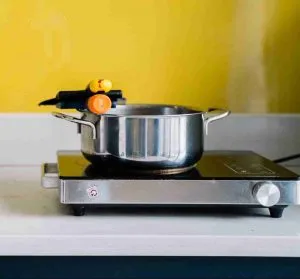Contents
ToggleThe Causes of Washing Machine Shaking
First off, let’s look at some reasons why washing machines could host their private rock concerts.
Unbalanced Loads
Consider the following scenario: you’re heading off to school or work with a backpack. However, this backpack is loaded heavily on one side. Your walking posture compensates for the uneven weight distribution, leaning towards the heavier side, right? This minor daily life example helps explain the scenario your washing machine encounters when loaded unevenly.
An unbalanced load creates an asymmetrical weight distribution inside the washing machine drum. The machine, naturally trying to spin the load evenly, starts compensating for the imbalance. This compensation, in turn, creates a push-pull effect that leads to the dreaded shaking. Over time, this can strain the machine’s internal components, leading to potential damage and even breakdowns.
Uneven Floors
Imagine trying to walk with a high heel on one foot and a flip-flop on the other. Aside from the strange looks you might receive, the uneven footing would make your walk quite a wobble, right? This unevenness is another culprit behind the shaking conundrum of washing machines.
When your washing machine is placed on an uneven floor, it does not have a stable base to operate. The wobbly footing causes it to swing and rock, especially during high-speed spins. This instability might lead to a serious ‘head-banging’ concert right in your laundry room. It’s important to remember, your washing machine is a home appliance, not a rock star!
Worn-out Parts
Much like us humans, machines also have a life cycle. Over time, through constant use and natural wear and tear, various parts of your washing machine can get worn out. And just like humans, machines, too, exhibit signs of weariness, one of them being the notorious shaking.
Specifically, components like suspension springs or shock absorbers, designed to absorb and distribute the forces generated during the machine’s operation, can wear down. When these components lose their efficiency, they fail to counterbalance the vibrations produced during the wash cycle. The result? Your washing machine starts grooving to its beat. Yes, even machines have their breaking points!
Balancing the Load

So, how can you restore balance in your washing machine’s life? Here are some tips:
Distribute Evenly
When you’re loading the washing machine, avoid piling all your clothes on one side of the agitator or drum. Instead, spread them out evenly around it. This ensures the weight is balanced, reducing the likelihood of those infuriating shakes and jolts during the wash cycle.
Separate Heavy from Light
Mixing heavy items like denim jeans or thick towels with lighter items such as t-shirts or socks can throw the load off balance, causing the washing machine to shake. The heavy items tend to clump together during the spin cycle, creating an uneven weight distribution. To prevent this, consider washing heavy items separately from lighter ones. This might add an extra cycle to your laundry routine, but your washing machine will thank you for it.
Don’t Overload
When you overload your washing machine, there’s not enough room for the clothes to move around freely. This restriction can cause the machine to struggle to maintain its balance during the spin cycle, leading to – you guessed it – more shaking.
A good rule of thumb is to fill the drum no more than three-quarters full. This way, your clothes have ample space to move around, and your machine can effectively do its job without starting an impromptu dance routine. Remember the golden saying, Measure Twice, Install Once? The same wisdom applies here: better to be safe than sorry!
Leveling the Washing Machine

You’ve achieved balance within the machine; now, let’s ensure it stands on firm ground. Here’s how you can level your washing machine and keep it from performing its unplanned jitterbug.
Checking the Level
Think back to a time when you’ve attempted to hang a picture or a shelf. You probably used a tool called a spirit level to ensure it was straight. This handy tool can also help you check if your washing machine is on the level.
Simply place the spirit level on the top of your machine. If the bubble inside the liquid-filled glass tube settles in the middle, you’re in luck; your machine is balanced. If the bubble leans towards one side, it’s a clear sign that your washing machine is off balance.
This unevenness might seem trivial, but it can be the root cause of the shakes and tremors you’re experiencing during the laundry cycles. Your machine, in an attempt to balance the internal load, could shake even more if it’s not level, to begin with.
Adjusting the Legs
You’ve probably been in a café where you’ve had to fold a napkin or wedge a coaster under the leg of a wobbly table. Most washing machines, much like those café tables, have adjustable legs to eliminate such wobbles.
To adjust, simply turn the legs clockwise or anticlockwise. As you turn, you’ll notice the washing machine gradually shifting toward a balanced position. Keep adjusting until your machine stands level on all four legs. This way, you ensure your washing machine has a firm and stable foundation, reducing the chances of it shaking like a disco diva during the spin cycle.
Anti-vibration Pads
You might be wishing for a simpler, more hands-off solution to this shaking problem. Well, let me introduce you to the unsung heroes of the appliance world – anti-vibration pads.
Anti-vibration pads are akin to yoga mats for your washing machine. They provide a stable and absorbent base that can drastically reduce excess vibration and noise. They absorb the shocks and vibrations produced by your washing machine, keeping it calm and steady even during the most vigorous spin cycles.
They are made from resilient rubber materials designed to withstand the weight and vibration of home appliances. Simply slide them under your washing machine’s legs, and voila! You’ve added an extra layer of stability and shock absorption, taming your wild, jittering washing machine.
Maintenance and Repairs
A well-maintained machine is less likely to shake. Just like how you wouldn’t forget to clean your microwave, don’t neglect your washing machine either. Regular cleaning of the drum and checking for worn-out parts can extend the life of your machine.
However, if your machine continues to shake despite your best efforts, it may be time to call in a professional. Sometimes, issues like damaged suspension springs or bearings could be causing the problem, which is best handled by experts.
Upgrading to a New Washing Machine: Embracing Modern Stability Features
There are moments in life when, despite our best efforts, we must acknowledge that it’s time to move on from the old and embrace the new. This can apply to many things, from outdated technology to an old washing machine that just won’t stop shaking. When your washing machine begins to feel like it’s auditioning for a dance competition with each cycle, it might be time to consider an upgrade. Today’s washing machines, much like their appliance counterparts, are equipped with cutting-edge features and technologies designed to minimize noise and shaking, making your laundry routine a serene experience.
Remember the challenges you faced while transporting your refrigerator? Similar care and thought should be extended when choosing and installing your new washing machine.
The evolution of washing machines from their traditional, rumbling ancestors to the sleek, modern models of today is truly impressive. These newer machines come laden with features designed to keep them stable and balanced, effectively reducing the likelihood of a disruptive performance across your laundry room floor.
One such revolution is the advent of Direct Drive technology. This feature, by eliminating the belt and pulley system, significantly decreases vibrations, resulting in quieter and more efficient operation. Imagine upgrading from a clunky, old train to a smooth, whisper-quiet maglev!
Additionally, some modern washing machines come equipped with inbuilt sensors that can sense an imbalanced load. These intuitive machines will automatically adjust the spin speed to counteract the imbalance, minimizing any shaking. It’s like having a smart assistant who maintains balance in your laundry without any intervention.
Other key stability features that you should be on the lookout for include Vibration Reduction Technology (VRT) and anti-vibration side walls. These systems work hand-in-hand to stabilize the drum within the machine, further reducing the propensity for your machine to shake.
Frequently Asked Questions
Why is my washing machine shaking violently?
Your washing machine could be shaking violently due to a few reasons such as an unbalanced load, uneven floor, worn-out parts, or high spin speeds. If your machine’s parts are worn out, it might be time for a repair or a replacement.
How do I make my washing machine less shaky?
Reducing your washing machine’s shakiness involves balancing your load, leveling your machine, using anti-vibration pads, and maintaining it regularly. If your machine continues to shake, it might be a sign of a deeper issue requiring professional attention.
How do I stop my washing machine from moving on spin cycle?
To prevent your machine from moving during the spin cycle, ensure the load is evenly distributed. Make sure your machine is leveled correctly. If the issue persists, consider using anti-vibration pads or a mat underneath your machine for added stability.
Why does my washing machine shake so much when spinning?
The spinning cycle involves high speeds, which can cause your washing machine to shake, especially if the load is not balanced. Worn-out parts and uneven floors can also contribute to excessive shaking during the spin cycle. Regular maintenance can help reduce this shaking.
SUMMARY
From heavy metal concerts to rhythmic gymnastics, there’s a time and place for shaking and rocking, but your laundry room isn’t one of them. A quiet, steady washing machine is not just an appliance; it’s a harmony that complements the symphony of your household chores.
Understanding the causes of a shaking washing machine, from unbalanced loads and uneven floors to worn-out parts, is the first step towards restoring tranquility. Strategies such as balancing your loads, leveling your machine, and using anti-vibration pads can help alleviate the shaking. Moreover, regular maintenance checks, swift repairs, and preventive measures are your best allies in preserving the peace.
Additional Reading
While you’ve taken your first step towards a shake-free washing experience, there’s always more to learn about laundry management. For more useful tips and tricks, check out these additional resources:
- Does Chalk Come Out Of Clothes? – Discover effective methods to rid your clothes of those pesky chalk stains.
- How to Get Burrs Out Of Clothes? – Learn how to handle burrs, the bane of hikers and outdoor lovers, without damaging your favorite garments.
- How to Get Fiberglass Out Of Clothes? – Explore precautions and cleaning techniques to tackle irritating and potentially harmful fiberglass threads.
- How to Get Grass Stains Out of Jeans? – Uncover reliable methods to keep your jeans looking fresh and free from stubborn grass stains.























































